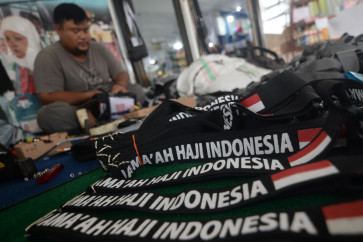Indonesia’s new stunting policy: Elusive or feasible?
Evidence shows that political leadership especially at the presidential or prime minister’s office is one of the key drivers to accelerate stunting decline.
Change text size
Gift Premium Articles
to Anyone

I
ndonesia has recently launched a new childhood stunting policy through Presidential Decree (Perpres) No. 72/2021 on the acceleration of stunting reduction among children under five years. This new policy effectively underpins the National Strategy to Accelerate Stunting Prevention 2018-2024.
Stunting, low height for age, is a physical manifestation of chronic malnutrition that carries long-term development risks.
Stunting in early life is linked with impaired cognitive ability, lower future productivity and higher risk of poverty. Stunting reflects the face of poverty and social inequalities.
While a poverty line using purchasing power parity (PPP) rates can be problematic to compare poverty across regions or countries because the consumption choices of the poor is not always captured by the basket of goods used to establish PPP measures, stunting prevalence can complement monetary welfare indicators.
Since the sources of stunting are multifaceted from immediate causes (inadequate dietary intake and disease), underlying causes (food insecurity, inadequate care and health services and unhealthy household environment) to basic causes (political, environmental context and socioeconomic factors such as income, parental education and unequal access to resources), high rates of stunting prevalence reveal the inability to meet most basic needs.
Stunting prevalence among under-five children in Indonesia had decreased from 37.2 percent in 2013, to 27.7 percent in 2019. Perpres No. 72/2021 targets further reduction in stunting to reach the prevalence rate of 14 percent by 2024. Is it attainable?
The answer will depend on an interplay of various factors affecting the implementation of such a policy. Among the classic literature on policy implementation, Sabatier and Mazmanian lay out several conditions of effective policy implementation, which can be pertinent to assess the efficacy of Indonesia’s stunting policy.
First, the program resulting from the policy should be based on a reliable theory of change to achieve desired objectives. The National Strategy to Accelerate Stunting Prevention 2018-2024 incorporates evidence-based interventions that address stunting through nutrition-specific actions (those tackling the immediate causes of stunting) and nutrition-sensitive actions (those tackling the underlying causes of stunting). Involving 23 ministries, the program also mainstreams a multisectoral approach that appears to be the most effective way to address stunting because the determinants of stunting are so complex and multifaceted. Thus, in theory, the causal pathway to stunting reduction in Indonesia is sound.
Second, the policy must contain unambiguous directives and clearly structure the implementation processes so as to enhance compliance of both implementing agencies and the behavior of target groups. While the Perpres articulates who is doing what at the national, provincial, district and village levels, it still leaves ambiguous room when it comes to funding. In the context of decentralization, funding is a tricky issue since the fiscal capacity of Indonesian districts varies greatly, coupled with varied levels of attention and efforts.
The third condition for effective policy implementation is that implementing actors have managerial and political skills in utilizing available resources. Indonesia may have enough resources since all the necessary programs already exist across 23 ministries in all key sectors to tackle stunting, but the lack of service delivery in Indonesia is largely a management problem rather than a resource problem according to the World Bank.
Financial mechanisms to designate nutrition funding should be created and used in a transparent way, along with continuous efforts to strengthen personal and organizational capacities.
Finally, constant political support is required throughout the implementation to make it effective. This condition is essential and yet challenging to obtain because in general people have episodic issue-attention span. We would need cohesive and responsive actor networks to sustain commitment.
Evidence shows that political leadership especially at the presidential or prime minister’s office is one of key drivers to accelerate stunting decline, which was the case in Brazil, Peru and Ethiopia.
A recent systematic review of child stunting determinants globally finds the five strongest drivers of improved linear growth outcomes: improved household income; higher level of parental education; improved hygiene and sanitation; optimal access to key maternal health services and improved family planning, as a longer time interval between births is associated with lower odds of stunting.
It is worth noting that the National Population and Family Planning Board (BKKBN) is appointed to be the lead implementing agency for Indonesia’s stunting policy. This implies that Indonesia may emphasize the family-oriented approaches to address stunting, since the BKKBN structurally has village-level cadres who are in touch directly with families.
However, this also poses a risk of the BKKBN being too technical and much less political in leading multisectoral coordination, whereas political calculations are at the heart of effective coordination. Indeed, the basic causes of malnutrition are dominated by the competing interests and incentives of different actors in nutrition, engendering wider structural causes of unequal access to resources.
To this extent, executive leadership from the President or Vice President should give the BKKBN sufficient political leverage to convene other actors and fulfill its role in leading the implementation of stunting policy.
After all, “policy is what it does.” This aphorism of Bernard Schaffer reminds us that a well-designed policy can only be judged through its implementation and the manifestation of change on the ground. The economic rationale for investing in stunting-reduction efforts is clear: stunting is estimated to cost Indonesia’s gross domestic product 2-3 percent per year, while every $1 invested in reducing stunting through programs in Indonesia is estimated to generate $17.9 to $18.4 in economic returns.
More importantly, there is a moral imperative in the name of equity to ensure that every child has the same opportunity to grow and develop their potential regardless the lottery of which part of the country or which family they were born into.
***
The writer is a PhD student in International Development at School of Advanced International Studies (SAIS), Johns Hopkins University, Washington DC.









